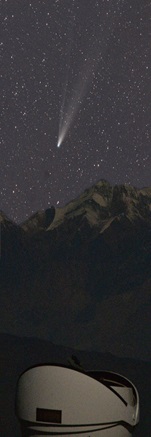
MASTER-OAFA
En 2011 se firmó un Acuerdo Internacional de Cooperación entre el Observatorio Astronómico “Félix Aguilar” (OAFA) y la Universidad Nacional de Moscú, para la instalación de un sistema electrónico de cámaras llamado MASTER I, localizado en la Estación Carlos U. Cesco, dependiente del OAFA y cercano a la imponente cordillera de Los Andes.
A continuación, en 2016, se amplió el Acuerdo para realizar la construcción de la cúpula que alberga al telescopio, lo cual sumado a las cámaras previamente instaladas, se lo renombró MASTER-OAFA. Este telescopio comenzó a operar en el marco de la red MASTER desde junio de 2016, funcionando normalmente bajo el excelente cielo de Los Andes argentinos.
Existe una red de 8 observatorios Master distribuidos en Rusia, España, Sudáfrica y Argentina, que llevan trabajando más de diez años.
La principal corriente de astrofísica moderna está relacionada con el estudio de objetos de destellos de corta duración en el cielo. Para estudiar tales objetos, se necesitan telescopios robóticos veloces con un amplio campo de visión.
Por mucho tiempo, los principales objetos de la astronomía que entendía sobre el tiempo fueron los estallidos de rayos gama (GRB). En el estudio de radiación óptica de los GRB, la red MASTER hizo una importante contribución: por ejemplo, el descubrimiento de la polarización de la emisión óptica de los GRB. También son importantes las continuas observaciones de cientos de cuadrantes de error de varios estallidos realizados por la red MASTER en un periodo superior a diez años en la rutina diaria.
Ahora, con el lanzamiento de detectores de ondas gravitacionales y el reciente descubrimiento de Kilonova, (significa una Estrella Nova que incrementa su brillo mil veces, diferente de una Estrella Supernova que incrementa su brillo un millón de veces), independientemente detectadas por diversos telescopios, incluyendo al MASTER, la detección de “transients” (sucesos irrepetibles y rápidos) en grandes cuadrantes de error, adquiere un nuevo significado. Ese trabajo ayuda a conectar métodos diferentes (por su naturaleza física) de explorar el universo.
La creación de una red completamente robótica basada en el telescopio MASTER III con un metro de diámetro, resolverá uno de los siguientes números de problemas científicos fundamentales a nivel mundial.1). La localización y estudio ópticos de las fuentes gravitacionales registrados en los proyectos LIGO / VIRGO;
2). Localización e investigación de las explosiones de rayos gamma -las más potentes explosiones del universo;
3). Detección de los objetos más distantes en el universo;
4). Respaldo para la investigación multicanal de las fuentes de energía ultra-altas de neutrino, cuya naturaleza es tema de estudio de los amplios experimentos físicos de IceCUBE y ANTARES, BAYKAL, BAKSAN.
Además, con la adopción de este tipo de telescopio puede realizarse una significativa contribución a la detección y notificación de las amenazas espaciales (asteroides potencialmente erráticos, cometas y objetos cercanos a la Tierra).
Argentina y Rusia ya han estado colaborando exitosamente con el proyecto MASTER por varios años. Anhelamos continuar en este camino y ampliar estos vínculos científicos.
ASIPEG Area
MASTER
Between the “Félix Aguilar” Astronomical Observatory (OAFA) and the Moscow State University, Russia, in 2011 an agreement of International cooperation was signed for the installation of a system of electronic cameras called MASTER I, located in the Carlos U. Cesco Station belonging to the OAFA and next to the imposing Andes mountain range.
Subsequently, in 2016, the agreement for the construction of the dome that housed a telescope was extended, which together with the previously installed cameras was renamed MASTER-OAFA. This telescope began operating within the MASTER net since June 2016, working regularly below the excellent sky of the Argentine Andes.
There is a net of 8 Master observatories in Russia, Spain, South Africa and Argentina that have been in operation for over ten years.
The main stream of modern astrophysics is related to the study of short-lived flare objects in the sky. To study such objects, fast robotic telescopes with a large field of view are needed.
For a long time, the main objects of time domain astronomy were gamma-ray bursts (GRB). In the study of GRB optical radiation, the MASTER net made an important contribution: for example, the discovery of the polarization of the GRB optical emission. Continuous observations of hundreds of error boxes of various bursts made by the MASTER-net over a period of more than ten years in the daily routine are also very important.
Now, with the launching of gravitational-wave detectors and the recent discovery of Kilonova (it means a Nova Star that increases its brightness a thousand times, different from a Supernova Star that increases its brightness a million times), independently detected by several telescopes, including MASTER, the detection of transients (unrepeatable and fast occurrences) in large error boxes gets a new meaning. Such work helps to connect different (by their physical nature) methods of exploring the universe.
The creation of a fully robotic net based on the MASTER III telescope with a one-meter diameter will solve a number of the following fundamental scientific problems at world level.
1.) Optical localization and study of sources of gravitational waves recorded in LIGO / VIRGO projects;
2). Optical localization and investigation of gamma-ray bursts – the most powerful explosions in the universe;
3). Detection of the most distant objects in the universe.
4). Support for multichannel research of ultrahigh-energy neutrino sources, the nature of which is the subject of study of the large physical experiments Ice CUBE and ANTARES, BAYKAL, BAKSAN.
In addition, taking such a telescope, a significant contribution to the detection and notification of space threats (potentially hazardous asteroids, comets and near-Earth objects) could be made.
Argentina and Russia have already been successfully collaborating with the MASTER project for several years. We look forward to continuing this path and to further expanding these scientific relationships.

